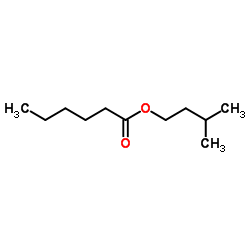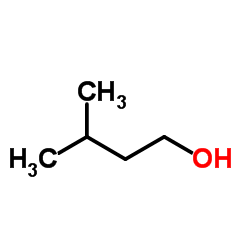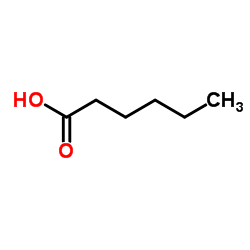2198-61-0
| 中文名 | 己酸异戊酯 |
|---|---|
| 英文名 | 3-methylbutyl hexanoate |
| 中文别名 | 己酸-3-甲基丁酯 |
| 英文别名 |
hexanoic acid,3-methylbutyl ester
hexanoic acid isopentyl ester MFCD00027280 Isopentyl caproate Isopentyl-n-hexanoate IsoaMyl Hexanoate (contains 2-Methylbutyl Hexanoate) Isopentyl alcohol,hexanoate Isopentyl hexanoate Isoamyl caproate Isoamyl Hexanoate 3-Methylbutyl hexanoate Hexansaeure-isopentylester Hexanoic acid, 3-methylbutyl ester EINECS 218-600-8 |
| 密度 | 0.9±0.1 g/cm3 |
|---|---|
| 沸点 | 225.5±0.0 °C at 760 mmHg |
| 熔点 | 250 - 251ºC |
| 分子式 | C11H22O2 |
| 分子量 | 186.291 |
| 闪点 | 82.9±8.3 °C |
| 精确质量 | 186.161987 |
| PSA | 26.30000 |
| LogP | 4.24 |
| 外观性状 | 黑色粉末 |
| 蒸汽压 | 0.1±0.4 mmHg at 25°C |
| 折射率 | 1.425 |
| 储存条件 | 室温 |
| 分子结构 | 1、 摩尔折射率:54.74 2、 摩尔体积(cm3/mol):213.9 3、 等张比容(90.2K):491.9 4、 表面张力(dyne/cm):27.9 5、 极化率(10-24cm3):21.70 |
| 计算化学 | 1.疏水参数计算参考值(XlogP):3.7 2.氢键供体数量:0 3.氢键受体数量:2 4.可旋转化学键数量:8 5.互变异构体数量:无 6.拓扑分子极性表面积26.3 7.重原子数量:13 8.表面电荷:0 9.复杂度:130 10.同位素原子数量:0 11.确定原子立构中心数量:0 12.不确定原子立构中心数量:0 13.确定化学键立构中心数量:0 14.不确定化学键立构中心数量:0 15.共价键单元数量:1 |
| 更多 | 1. 性状:无色液体呈苹果和菠萝似香味。 2. 相对密度(g/mL,15/4ºC):0.860 3. 相对蒸汽密度(g/mL,空气=1):未确定 4. 熔点(ºC):未确定 5. 沸点(ºC,常压):222 6. 沸点(ºC,20mmHg):未确定 7. 折射率(20ºC):1.4180~1.422 8. 闪点(ºF):185 9. 比旋光度(): 未确定 10. 自燃点或引燃温度(ºC):未确定 11. 蒸气压(kPa,100ºC):未确定 12. 饱和蒸气压(kPa,20ºC):未确定 13. 燃烧热(KJ/mol):未确定 14. 临界温度(ºC):未确定 15. 临界压力(KPa):未确定 16. 油水(辛醇/水)分配系数的对数值:未确定 17. 爆炸上限(%,V/V):未确定 18. 爆炸下限(%,V/V):未确定 19. 溶解性:溶于乙醇、非挥发性油和矿物油,不溶于丙二醇、水和甘油。 |
|
Section I.Chemical Product and Company Identification Chemical Name n-Caproic Acid Isoamyl Ester Portland OR SynonymIso-amyl n-Caproate CH3(CH2)4COO(CH2)2CH(CH3)2 Chemical Formula CAS Number2198-61-0
Section II.Composition and Information on Ingredients Chemical NameCAS Number Percent (%)TLV/PELToxicology Data n-Caproic Acid Isoamyl Ester2198-61-0---------- Not available.Rabbit LD50 (dermal) >5000mg/kg Rat LD50 (oral) >5000mg/kg Section III. Hazards Identification Acute Health EffectsNo specific information is available in our data base regarding the toxic effects of this material for humans. However, exposure to any chemical should be kept to a minimum. Skin and eye contact may result in irritation. May be harmful if inhaled or ingested. Always follow safe industrial hygiene practices and wear proper protective equipment when handling this compound. Chronic Health EffectsCARCINOGENIC EFFECTS : Not available. MUTAGENIC EFFECTS : Not available. TERATOGENIC EFFECTS : Not available. DEVELOPMENTAL TOXICITY: Not available. Repeated exposure to an highly toxic material may produce general deterioration of health by an accumulation in one or many human organs. Section IV.First Aid Measures Eye Contact Check for and remove any contact lenses. IMMEDIATELY flush eyes with runing water for at least 15 minutes. keeping eyelids open. COLD water may be used. DO NOT use an eye oitment. Flush eyes with running water for a minimum of 15 minutes, occasionally lifting the upper eyelids. Seek medical attention. Treat symptomatically and supportively. Skin ContactAfter contact with skin, wash immediately with plenty of water. Gently and thorough wash the contaminated skin with running water and non-abrasive soap. Be particularly careful to clean folds, crevices, creases and groin. COLD water may be used. Cover the irritated skin with an emollient. Seek medical attention. Treat symptomatically and supportively. Wash any contaminated clothing before reusing. InhalationIf the victim is not breathing, perform artificial respiration. Loosen tight clothing such as a collar, tie, belt or waistband. If breathing is difficult, oxygen can be administered. Seek medical attention. Treat symptomatically and supportively. IngestionINDUCE VOMITING by sticking finger in throat. Lower the head so that the vomit will not reenter the mouth and throat. Loosen tight clothing such as a collar, tie, belt, or waistband. If the victim is not breathing, administer artificial respiration. Examine the lips and mouth to ascertain whether the tissues are damaged, a possible indication that the toxic material was ingested; the absence of such signs, however, is not conclusive. Seek immediate medical attention and, if possible, show the chemical label. Treat symptomatically and supportively. Section V. Fire and Explosion Data Not available. FlammabilityCombustible.Auto-Ignition Flash PointsFlammable Limits 85°C (185°F).Not available. Combustion Products These products are toxic carbon oxides (CO, CO 2). Fire Hazards No specific information is available regarding the flammability of this compound in the presence of various materials. Explosion HazardsRisks of explosion of the product in presence of mechanical impact: Not available. Risks of explosion of the product in presence of static discharge: Not available. No additional information is available regarding the risks of explosion. Fire Fighting Media SMALL FIRE: Use DRY chemicals, CO 2, water spray or foam. and InstructionsLARGE FIRE: Use water spray, fog or foam. DO NOT use water jet. Continued on Next Page n-Caproic Acid Isoamyl Ester Section VI.Accidental Release Measures Spill CleanupCombustible material. InstructionsKeep away from heat and sources of ignition. Mechanical exhaust required. Stop leak if without risk. Finish cleaning the spill by rinsing any contaminated surfaces with copious amounts of water. Consult federal, state, and/or local authorities for assistance on disposal. Section VII. Handling and Storage Handling and StorageCOMBUSTIBLE. Handle with caution and minimize exposure. Keep away from heat and sources of ignition. Mechanical exhaust required. Avoid excessive heat and light. DO NOT ingest. Do not breathe gas, fumes, vapor or spray. Wear Information suitable protective clothing. If ingested, seek medical advice immediately and show the container or the label. Treat symptomatically and supportively. Always store away from incompatible compounds such as oxidizing agents. Section VIII. Exposure Controls/Personal Protection Engineering ControlsProvide exhaust ventilation or other engineering controls to keep the airborne concentrations of vapors below their respective threshold limit value. Ensure that eyewash station and safety shower is proximal to the work-station location. Personal ProtectionSplash goggles. Lab coat. Dust respirator. Boots. Gloves. Suggested protective clothing might not be sufficient; consult a specialist BEFORE handling this product. Exposure LimitsNot available. Section IX. Physical and Chemical Properties Physical state @ 20°CColorless liquid.Solubility Not available. 0.86 Specific Gravity Molecular WeightPartition Coefficient 186.29Not available. Boiling PointVapor Pressure 222°C (431.6°F)Not available. Melting PointNot available.Vapor DensityNot available. Refractive IndexNot available.VolatilityNot available. Critical TemperatureNot available.OdorNot available. ViscosityNot available.TasteNot available. Section X.Stability and Reactivity Data Stability This material is stable if stored under proper conditions. (See Section VII for instructions) Conditions of Instability Avoid excessive heat and light. Incompatibilities Reactive with strong oxidizing agents. Section XI. Toxicological Information RTECS NumberMO8389300 Routes of ExposureEye contact. Ingestion. Inhalation. Toxicity DataRabbit LD50 (dermal) >5000mg/kg Rat LD50 (oral) >5000mg/kg Chronic Toxic EffectsCARCINOGENIC EFFECTS : Not available. MUTAGENIC EFFECTS : Not available. TERATOGENIC EFFECTS : Not available. DEVELOPMENTAL TOXICITY: Not available. Repeated exposure to an highly toxic material may produce general deterioration of health by an accumulation in one or many human organs. Acute Toxic EffectsNo specific information is available in our data base regarding the toxic effects of this material for humans. However, exposure to any chemical should be kept to a minimum. Skin and eye contact may result in irritation. May be harmful if inhaled or ingested. Always follow safe industrial hygiene practices and wear proper protective equipment when handling this compound. Continued on Next Page n-Caproic Acid Isoamyl Ester Section XII.Ecological Information EcotoxicityNot available. Environmental FateNot available. Section XIII. Disposal Considerations Recycle to process, if possible. Consult your local or regional authorities. You may be able to dissolve or mix material with Waste Disposal a combustible solvent and burn in a chemical incinerator equipped with an afterburner and scrubber system. Observe all federal, state, and local regulations when disposing of the substance. Section XIV. Transport Information DOT ClassificationNot a DOT controlled material (United States). PIN NumberNot applicable. Proper Shipping Name Not applicable. Packing Group (PG)Not applicable. DOT Pictograms Section XV. Other Regulatory Information and Pictograms TSCA Chemical InventoryThis compound is ON the EPA Toxic Substances Control Act (TSCA) inventory list. (EPA) WHMIS Classification WHMIS CLASS B-3: Combustible liquid with a flash point between 35°C (100°F) and 93.3°C (200°F). (Canada) EINECS Number (EEC) 218-600-8 EEC Risk StatementsNot available. SECTION 16 - ADDITIONAL INFORMATION N/A |
|
毒理学数据: 1、皮肤/眼睛刺激性:兔子,皮肤接触,标准Draize试验:500mg/24H,轻度反应 2、急性毒性:大鼠经口LD50:>5mg/kg;;兔子,皮肤接触LD50:>5mg/kg 生态学数据: 对水是稍微有害的,不要让未稀释或大量的产品接触地下水,水道或者污水系统,若无政府许可,勿将材料排入周围环境 CHEMICAL IDENTIFICATION
HEALTH HAZARD DATAACUTE TOXICITY DATA
|
| 危害码 (欧洲) | Xi |
|---|---|
| WGK德国 | 2 |
| RTECS号 | MO8389300 |
| 包装等级 | III |
| 海关编码 | 29349990 |
|
~% 
2198-61-0 |
| 文献:Chemische Berichte, , vol. 101, p. 2435 - 2444 |
| 海关编码 | 2915900090 |
|---|---|
| 中文概述 | 2915900090. 其他饱和无环一元羧酸及其酸酐(酰卤、过氧)化物、过氧酸及其卤化、硝化、磺化、亚硝化衍生物. 增值税率:17.0%. 退税率:9.0%. 监管条件:AB(入境货物通关单,出境货物通关单). 最惠国关税:5.5%. 普通关税:30.0% |
| 申报要素 | 品名, 成分含量, 用途 |
| 监管条件 | A.入境货物通关单 B.出境货物通关单 |
| 检验检疫 | R.进口食品卫生监督检验 S.出口食品卫生监督检验 M.进口商品检验 N.出口商品检验 |
| Summary | 2915900090 other saturated acyclic monocarboxylic acids and their anhydrides, halides, peroxides and peroxyacids; their halogenated, sulphonated, nitrated or nitrosated derivatives VAT:17.0% Tax rebate rate:9.0% Supervision conditions:AB(certificate of inspection for goods inward,certificate of inspection for goods outward) MFN tariff:5.5% General tariff:30.0% |



